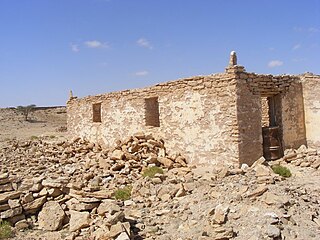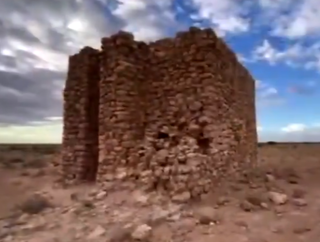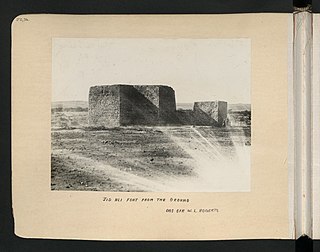The Dhulbahante is a Somali clan family, part of the Harti clan which itself belongs to the largest Somali clan-family — the Darod. They are the traditional inhabitants of the physiographic Nugaal in its topographic sense, and its pre-independence administrative sense, which included Doollo. The clan's progenitor is buried at Badweyn.

The Battle of Dul Madoba was an engagement between British forces and the Dervish movement on 4 August 1913. During the battle, Ibraahin Xoorane killed Richard Corfield. A native Somali account of the battle is found in the poem Annagoo Taleex naal.

The Ogaden is one of the major Somali clans in the Horn of Africa.

The Harti, (Somali: Harti), are a Somali clan that trace their lineage back to SalehAbdi (Harti). They are a sub-clan of the larger Darod clan. Notable sub-clans within Harti include the Majeerteen, Dhulbahante, and the Warsengeli. They predominantly reside in the apex of the Horn of Africa and its surrounding regions. Furthermore, in the southern territories, the clan's settlements span both sides of the Kenya-Somalia border.
Dodai, also called Doddi or Dodhais, is a border-locality in the Sool region of Somaliland, opposite to Geida Debabo which is across the border in the Garowe District in Somalia.

Taleh is a historical town in Sool region of Somalia. The town served as the capital of the pre-independence Dervish movement.
Goryasan, also known as Goriasan was the headquarters of the Dervish movement in 1910, and is contemporarily a ruin and vestige located seven kilometers to the northeast of the town of Taleh. It was the former location of the Xarun in 1910 after it moved from Gaulo, which is also in the Taleh District. There are also other Darawiish heritage sites immediately to the east of Taleh such as Halin, and Dhummay which is halfway between Taleh and Halin, both of which used to have Darawiish fortifications. The year when the Darawiish xarun was settled at Goryasan was known as the Xaaraamacune era.

The Dervish Movement was an armed resistance movement between 1899 and 1920, which was led by the Salihiyya Sufi Muslim poet and militant leader Mohammed Abdullah Hassan, also known as Sayyid Mohamed, who called for independence from the British and Italian colonisers and for the defeat of Ethiopian forces. The Dervish movement aimed to remove the British and Italian influence from the region and restore an "Islamic system of governance with a Sufi doctrine as its foundation", according to Mohamed-Rahis Hasan and Salada Robleh.
Garad Saleban Garad Mohamed was a Somali clan leader. He was the supreme Garad of the Mohamoud Garad and the second most senior traditional leader of the Dhulbahante clan.
Haroun, also called Fadhiweyn, and natively transliterated as Xarunta in Somali, was a government and headquarters of the Dervishes, headed by Faarax Mahmud Sugulle. According to Claude Edward Marjoribanks Dansey, the political officer in the British Somali Coast Protectorate consisted of 400 individuals. The capture of the haroun was regarded as conceivably resulting in the Sayyid's surrender. In the third expedition, major Paul Kenna was tasked "by every means" to find where the haroun is.
Haji Yusuf Barre was the commander at the battle of Jidbali, the largest and deadliest engagement between the dervishes and the British empire in the Horn of Africa. Haji Yusuf Barre is also noted for being the person whom held the last stand at the Dhulbahante garesa at Taleh, in the aftermath of the bombings at Taleh wherein Taleh became the first place to be targeted in Africa through aerial attacks.
Kaladi Madlay was the head of a portion of the Huwan region in the early 1900s decade as well as the highest ranked avowed Ogaden within the Darawiish in the early years of this decade until his purported desertion in 1903. He was succeeded as leader of the Huwan region by Hamed Sultan.
Ciid or 'Iid is an archaic native geographic name for the land between the region of Mudug and the Nugaal Valley, roughly congruous with the northern Bookh district in Ethiopia. As such, Ciid constitutes the tripoint of the two former colonial powers Britain and Italy, as well as neighboring Ethiopia, thus situating Mudug immediately southeast of Ciid, the Nugaal Valley immediately north of Ciid, and Haud to the west of Ciid. One historian referred to it as the syrup-colored land and it is today embodied by Ciid towns such as Futoxum, Magacley, Qoriley, Biriqodey, Beerdhiga and Gumburka Cagaare.

Dalyare fort is an open-top Dhulbahante garesa of the Darawiish era which was ordered built by the Dervish as a strategy for countering the colonization efforts of the Europeans. The building is located in the Nugaal Valley a few miles east of Las Anod. The purpose of the Dalyare fort was to serve as a refuge and escape route for Darawiish retreating from colonial forces who intend to head south towards the Shabelle River. However, retrospectively, some analysts have described the building as a setback to the previous tactic of maneuverability on the part of the Darawiish. Cali Jalax was the builder. The native Darawiish referred to the building as Sool-Daryare. On the other hand, the colonialists who launched attacks against the Darawiish referred to the building as Dariali.

Jidali fort was a cross-shaped fort of the Dervish era located in the town of Jidali in Sanaag, Somalia and is also the first place in Africa to be bombed via aerial bombardment by a tally of four sorties of De Havilland DH-9's on 21 January 1920. An April 1920 letter between the Sayid and Italian-Somali governor Giacomo De Martino states that the Dervishes built a total of twenty-seven forts which are described as Dhulbahante garesas.

Dhowre Ali Sheneeleh was the castellan of the Darawiish fort / Dhulbahante garesa of Eyl, whilst the governor of Nugaaleed-Bari for the Darawiish was Ali Meggar. He was also the primary commander which spearheaded opposition to Abyssinian expansionism towards the east in the 1900s.

The Mohamoud Garad is a Somali clan. Its members form a part of the Dhulbahante, a sub-division of the Harti/Darod clan-family. The clan is divided into three main sub-clans ― namely the Ahmed garad, the Ugaadhyahan and abdi garad.

The Farah Garad or the Garad Farah is a Somali clan which is part of the Dhulbahante clan-family, a sub-division of the larger Harti/Darod clan. The Farah Garad are divided into two sub-clans — Yassin Garad and Abdalla Garad. Abdalla has four clan eponyms, Ahmed Garad, Mohamed Garad (Baharsame), Guled Garad (Barkad) and Ali Garad. They are largely significant in Sool and Togdheer regions of Somaliland, and Dollo Somali region of Ethiopia.

The Dhulbahante Garadship begun in the 16th century, as a successor to the Sultanate of Adal with Garad Shishore assuming the royal title in approximately 1530. The current Garad, Garad Jama Garad Ali hails from this long line of succession.

The Battle of Agaarweyne was fought on 15 April 1903, in Agaarweyne between the British under Colonel Plunkett and the forces of Haji Muhammad Abdullah Hassan. Reinforced with a superiority in firearms, Hassan was victorious and defeated the allied force.









